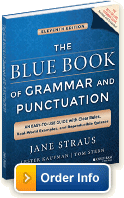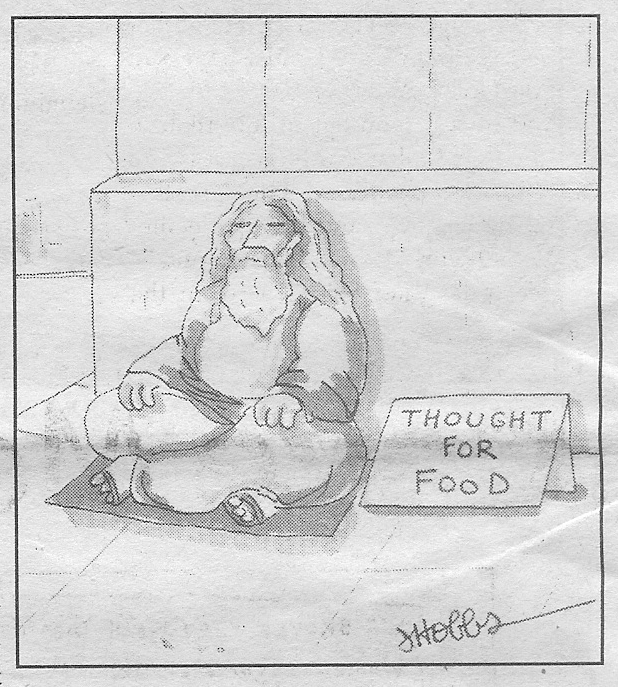|
Hi, Friend.
Welcome to your GrammarBook.com e-newsletter.
|
I am happy to have subscribed to the quizzes on GrammarBook.com. I now have a new chance to improve my grammar and overall proficiency in the use of English.
—Ben U.
I keep reading over The Blue Book of Grammar and Punctuation because there is so much great information there.
—Karen M.
Thank you for the tips in your weekly e-newletters. They really help me a lot.
—Mohammed E.
|
|
|
Among vs. Between
Many of you sent in comments on last week’s Year-End Quiz. The
question receiving the most comments was:
7. James is trying to decide between three college majors; accounting,
finance, or economics.
Our point with this question was to demonstrate that the semicolon should
instead be a colon. We didn’t anticipate the many comments
exemplified by this one from Kathi M.:
[S]hould it not be "among" instead of "between" because there are more than two choices?
Those of you who have copies of both the tenth and eleventh editions of The Blue Book of Grammar and Punctuation will notice this among vs. between entry that was included in the “Confusing Words and Homonyms” section of the tenth edition:
among involves three or more
Example: Who among us has not lied?
between involves just two
Example: She couldn’t decide between Chinese and Thai food.
However, we dropped this entry from the eleventh edition (and from the Confusing Words and Homonyms section online) after determining that the distinction is more nuanced than simply how many options are involved.
The notion that between applies to two things and among to more than two is often, but not always, correct. Perhaps the misunderstanding derives from the fact that while among always applies to three or more things, it is only when those items are part of a
larger group or are not individually named. Between is used for two items as well as for more than two when they are specific, individual items.
Examples:
I must decide between going to work sick or working from home.
(between applies to two things)
Corina is able to choose between Stanford, Harvard, McGill, and Oxford for her future school.
(between applies to more than two individually named items)
Corina is able to choose from among the best universities in the world for her future school.
(among applies to more than two items that are part of a group or are not specifically named)
There are many more examples we could list, but you probably get the idea.
To further complicate our former simplistic notion about among vs. between, the Associated Press Stylebook had this to say:
The maxim that between introduces two items and among introduces more than two covers most questions about how to use these words …
However, between is the correct word when expressing the relationships of three or more items considered one pair at a time: Negotiations on a debate format are underway between the network and the Ford, Carter, and McCarthy committees.
We hope you can see now that the error in question No. 7 was just the semicolon, and that you can understand why we chose to omit among, between from the eleventh edition of The Blue Book.
We also wish to thank those of you who pointed out that lectern was misspelled in question No. 1. (Extra credit is awarded to George C. who paid close attention to our blog Words in Flux and pointed out that one stands on, not behind, a podium.)
In addition, we thank the alert readers who noted that the question and answer were reversed in No. 10. “A couple of dollars more could make a big difference” is the correct sentence.
You may click on the link to view the corrected and improved version of 2016’s Year-End Quiz.
Because of the e-newsletter’s large readership, please submit your English usage questions through GrammarBook.com’s “Grammar Blog.” |
|
Free BONUS Quiz for You!
Friend, because you are a subscriber to the newsletter, you get access to one of the Subscribers-Only Quizzes. Click here to take an Its vs. It's Quiz and get your scores and explanations instantly!
More Good News for Quiz Subscribers
We are pleased to announce that we have added even more quizzes to help you challenge yourself, your students, and your staff. We added quizzes to existing categories and created some new categories such as “Confusing Verbs,” “Subjunctive Mood,” “Comprise,” “Sit vs. Set vs. Sat,” and “Spelling.”
We reviewed and strengthened every quiz on our website to ensure consistency with the rules and guidelines contained in our eleventh edition of The Blue Book of Grammar and Punctuation.
If you think you have found an error in a quiz, please email us at help@grammarbook.com.

“So convenient … hundreds of quizzes in one click.”
Friend, Subscribe to receive hundreds of English usage quizzes not found anywhere else!
- Take the quizzes online or download and copy them.
- Get scored instantly.
- Find explanations for every quiz answer.
- Reproduce the quizzes to your heart’s content.
- EASY to use.
- No software to download.
- No setup time.
- A real person to help you if you have any questions!
Instructors and Employers: we make your life easier!
- Assign quizzes to your students or employees.
- Students log in from anywhere.
- Scores are tallied and compiled for you.
- You decide whether to let students see their own scores and quiz explanations.
- Let GrammarBook.com take the hassle out of teaching English!
“Fun to test my skills!”
“The explanations really help … thanks!”
Your choice: Subscribe at the $29.95 or $99.95 level ($30 off - previously $129.95).
“I download the quizzes for my students who don’t have computer access.”
Subscribe today to receive hundreds of English usage quizzes not found anywhere else!
“Makes learning English FUN!”
 |
Don’t need all the quizzes at once?
You can now purchase the same quizzes individually for ONLY 99¢ each. Purchase yours here. |

Get Yours Today!
Get Amazon’s No. 1 Best-seller in Four Categories!
No. 1 in Grammar
No. 1 in Reading
No. 1 in Lesson Planning
No. 1 in Vocabulary |
The Blue Book of Grammar
and Punctuation
by Jane Straus, Lester Kaufman, and Tom Stern
The Authority on English Grammar!
Eleventh Edition Now Available
Have You Ordered Your Copy Yet?
An indispensable tool for busy professionals, teachers, students, homeschool families, editors, writers, and proofreaders.
Available in print AND as an e-Book! Over 2,000 copies are purchased every month!
Order Your Copy Today!
- Hundreds of Grammar, Punctuation, Capitalization, and Usage Rules
- Real-World Examples
- Spelling / Vocabulary / Confusing Words
- Quizzes with Answers
The publisher of The Blue Book, Jossey-Bass, A Wiley brand, is offering a 35 percent discount for those of you who order the book through Wiley.com. Shipping and tax are not included. Simply go to bit.ly/1996hkA and use discount code E9X4A.
*Offer expires December 31, 2017.
|
Wordplay

With thanks to cartoonist Jeff Hobbs.
Learn all about who and whom, affect and effect, subjects and verbs, adjectives and adverbs, commas, semicolons, quotation marks, and much more by just sitting back and enjoying these easy-to-follow lessons. Tell your colleagues (and boss), children, teachers, and friends. Click here to watch. |